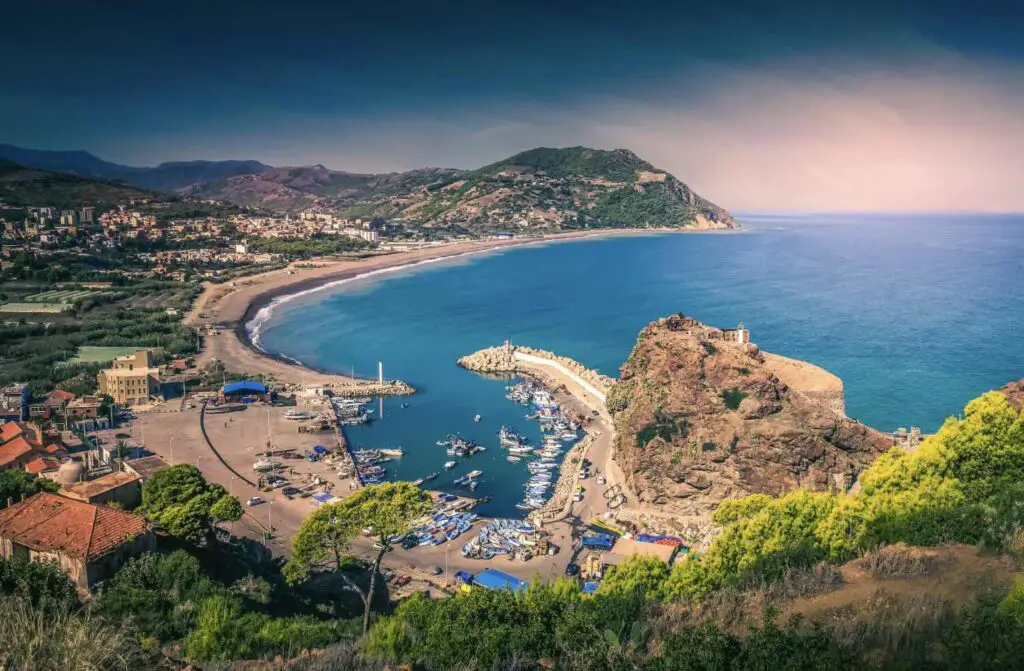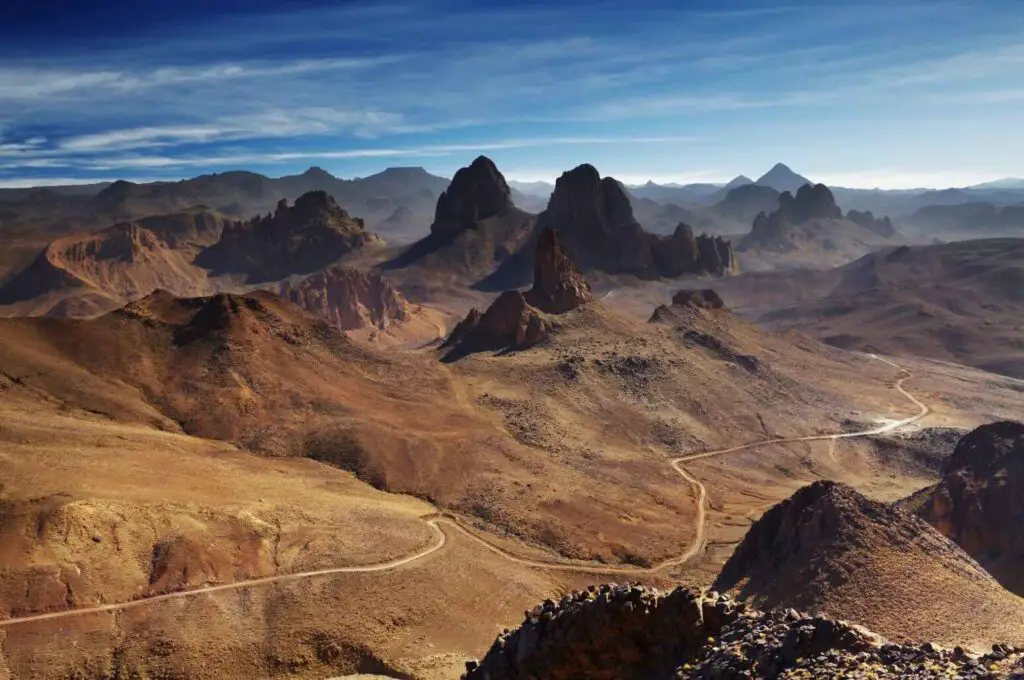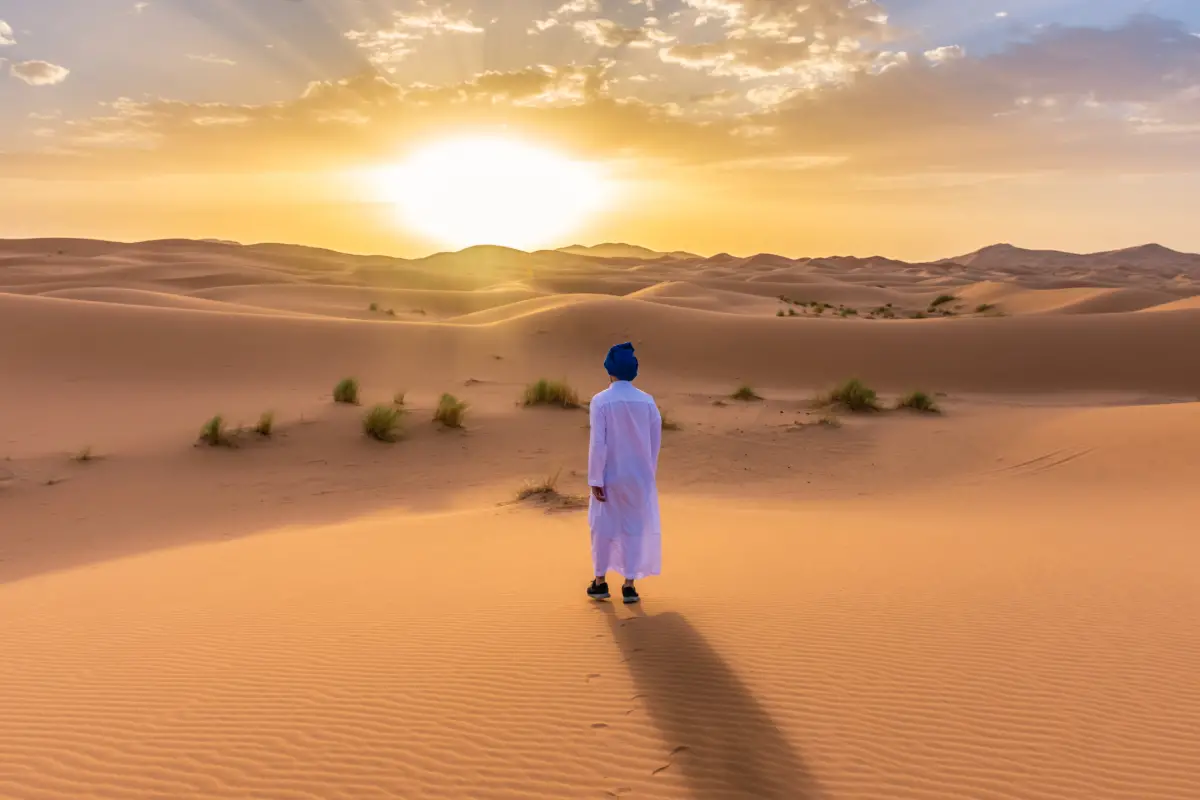Algeria’s vast landscapes and rich history present a compelling study of how geography shapes a nation’s identity, economy, and societal structures. This examination sheds light on the country’s multifaceted nature, revealing how its extensive territory influences various aspects of life.
Algeria’s geographical diversity is a backdrop for exploring its cultural richness, economic challenges, and environmental conservation efforts from the sweeping Sahara to the bustling cities along the Mediterranean coast.
Table of Contents
- Geographical Expanse and Location
- Historical Significance
- Economic Impact of Size
- Environmental Diversity and Conservation
- Cultural and Demographic Aspects
- Related Questions
Geographical Expanse and Location
Algeria is the largest country in Africa, stretching over an impressive 2,381,741 square kilometers. Its size is accentuated by its location: it sits comfortably at the top of the continent, bridging the expanse between Europe and Africa. A considerable portion of its landmass extends into the grand Sahara Desert.
This desert alone, one of the world’s most expansive sandy seas, contributes significantly to the country’s vast area, covering over 90% of its landscape.
Diving deeper into its geographical diversity, Algeria doesn’t stop at the Sahara. The country boasts various terrains, beginning with the fertile northern coastline along the Mediterranean Sea.
This verdant stretch contrasts sharply with the arid desert it borders. Heading south, the Tell Atlas and Saharan Atlas mountain ranges introduce a rugged landscape, offering the country’s geography backbone. These elevated terrains provide a sharper texture to the scenery, meandering from the Tunisian border in the east to the Moroccan frontier in the west.
Moreover, Algeria’s climatic conditions reflect its geographical diversity. The northern coastal region enjoys a Mediterranean climate with warm summers and mild winters. In contrast, the vast interior parts experience scorching summers and significantly cooler temperatures at night, characteristic of desert climates.
Surprisingly, despite its largely arid land, Algeria is not devoid of water sources. The Hoggar Mountains, rising majestically in the heart of the Sahara, capture enough rainfall to feed wadis and oasis towns, creating pockets of life in the arid expanse.
In essence, Algeria’s claim as the largest country in Africa is not just about its size but its geographical diversity. From rolling coastal lines and rugged mountain ranges to the endless sandy expanse of the Sahara and occasional lush oasis, Algeria presents a tapestry of landscapes that collectively contribute to its grand stature on the African continent.
The coexistence of different ecosystems within its borders showcases the complex natural beauty and geological variety that define its vastness.

Historical Significance
This vast expanse hasn’t just dictated the diversity of landscapes but has also been instrumental in shaping the country’s socio-political narrative through years of colonization and war for independence.
The sheer size of Algeria meant that during colonization, controlling such a large area was an arduous task for colonial powers. This expanse provided varied and numerous pockets for resistance to fester and grow. The struggle for independence was characterized by guerilla warfare and strategic use of the vast, hard-to-navigate terrains, especially the mountainous and desert regions, which served as natural fortresses for the resistance movements.
Algeria’s size and diversity of landscapes have significantly influenced the distribution of wealth and resources. The discovery of oil in the Sahara transformed the country’s economic landscape.
However, the concentration of oil wealth in specific regions has led to unequal development, highlighting the challenges of managing and distributing resources in such a vast country. Infrastructure development, crucial for economic growth, becomes enormous across varied and often rugged terrain, impacting everything from transportation to communication networks.
Culturally, Algeria’s size has fostered a rich mosaic of ethnicities and languages. From the Arab-Berber populations in the northern cities to the Tuareg and other nomadic peoples in the Sahara, this diversity manifests in the languages spoken and customs, traditions, and art.
The vast distances and distinct regions have helped preserve specific cultural identities while contributing to a shared sense of national identity forged through centuries of shared history and, notably, the fight for independence.
Socially, Algeria’s large geography has influenced settlement patterns, with densely populated coastal cities contrasting sharply with sparsely populated desert areas. This has implications for social services and government policies, which must be nuanced and region-specific, considering the different realities of urban versus rural living.
The sparse population in vast desert areas also presents unique challenges for community development and access to education and healthcare services.
Reflecting upon the post-independence period, Algeria’s size has continued to shape its pathways and potential. Governing such a vast territory presents ongoing challenges regarding national integration, infrastructure development, and equitable resource distribution. Yet, it also presents opportunities for sustainable development and utilization of the country’s natural resources and landscapes.
Through its sheer geographical scale, Algeria has journeyed through epochs that witnessed the ebb and flow of empires, colonization, fervent struggles for independence, and efforts toward national building and development.
Each phase of its history is a testament to how integral its size has been, not just as a background on which events unfolded but as an active element that influenced outcomes and shaped destinies. Algeria’s size remains central to its historical narrative and path forward, from ancient trade routes employing the vast Saharan tracks to the modern-day extraction of resources deep within these lands.

Economic Impact of Size
Algeria’s large expanse harbors significant fuel reserves, drawing substantial global investment into its oil and gas sectors. These sectors form the backbone of the economy and account for the lion’s share of government revenue.
These natural resources have also paved the way for Algeria to become a key player in the global energy market, exporting large quantities of oil and natural gas to various countries, thereby bolstering its economic stature on the international stage.
However, managing an economy that relies heavily on hydrocarbons also brings its fair share of vulnerabilities. Global oil market price fluctuations can lead to economic instability, affecting the country’s overall financial health. This dependency emphasizes the need for Algeria to diversify its economy beyond oil and gas to create a more sustainable economic foundation that can withstand global market shifts.
Algeria’s vast terrain also presents logistical challenges in connecting and maintaining infrastructure across its extensive reaches. Developing roadways, railways, and airports to ensure efficient transport and connectivity between remote areas and economic centers requires considerable investment. The elevated costs of extending infrastructure into isolated regions often slow development projects, impacting the equitable distribution of economic opportunities across Algeria’s vast landscapes.
Remote areas, particularly in the expansive Sahara, face issues of accessibility that restrict economic development. The difficulty in reaching these areas poses challenges not only for the exploitation of resources but also for the provision of social services and the integration of these regions into the national economy. This isolation can lead to disparities in wealth and development, spotlighting the need for targeted investments to bridge these divides.
Moreover, the monitoring and securing such a broad territory adds another layer of complexity, involving substantial resources and coordination. Safeguarding its extensive borders from illicit activities such as smuggling and maintaining the security of its crucial energy infrastructure is critical for national security and economic stability.
Algeria is looking into expanding renewable energy projects, notably solar power, given its desert areas receive abundant sunlight year-round to counterbalance these challenges. This move towards renewables helps diversify the economy and positions Algeria as a future leader in solar energy, leveraging its geographical advantage to foster sustainable economic growth.
Despite these hurdles, Algeria’s size and resource wealth offer a strategic advantage. A large domestic market and significant export capabilities provide Algeria with robust economic potential. With careful planning and diversification of its economy to mitigate the risks associated with over-reliance on hydrocarbons and to address infrastructural challenges, Algeria can harness its size and resources for sustained economic prosperity.

Environmental Diversity and Conservation
Algeria’s enormous size includes varied ecosystems with unique conservation challenges and opportunities. In the densely wooded areas of the Tell Atlas Mountains, efforts focus on preserving the native cedar forests that house an array of wildlife, including the endangered Barbary macaque.
This region’s ecosystem is crucial for biodiversity conservation yet faces threats from overgrazing and deforestation. Reforestation projects and controlled grazing zones have been initiated to combat these challenges, showcasing how Algeria’s diverse landscapes require tailored conservation approaches.
Transitioning from the green mountains to the arid Saharan region, the approach to conservation shifts dramatically. Protecting the vast barren landscapes is about conserving the unique species adapted to extreme desert conditions.
Initiatives in the Sahara include establishing protected areas to safeguard critically endangered species like the Saharan cheetah, Addax antelope, and Dama gazelle. These protected areas serve not only as a haven for threatened species but also as research zones better to understand desert ecosystems and the impacts of climate change.
Algeria’s coastal regions present another conservation priority, focusing on marine biodiversity and coastal ecosystems. Preserving coral reefs and seagrass beds is crucial for maintaining marine life and ensuring the livelihoods of communities dependent on fishing.
Conservation efforts along the Algerian coast include pollution control, sustainable fisheries practices, and establishing marine protected areas. There’s also a push to raise public awareness about the importance of coastal ecosystems and encourage community involvement in conservation initiatives.
The diverse Algerian climate, ranging from Mediterranean in the north to arid in the south, exacerbates the challenge of managing water resources. Conservationists work on sustainable water management projects that balance human needs with preserving wetlands and aquatic habitats, which are critical for biodiversity.
The Ramsar sites, such as Lake Tonga and El Kala National Park, are prime examples of wetland conservation in response to Algeria’s environmental diversity. These efforts showcase the interconnectedness of Algeria’s water systems and the significance of sustainable practices for ecosystem health.
Adapting to climate change is a cross-cutting theme in conservation efforts across all Algerian ecosystems. Strategies include habitat restoration, species relocation programs, and research into climate resilience. Given Algeria’s extensive coastline, there’s also a focus on preparing for sea-level rise and its impact on coastal ecosystems. These proactive measures highlight how conservation in Algeria is about preserving the status quo and preparing for future changes brought about by global warming.
Through these varied examples, one can see how Algeria’s size and environmental diversity influence conservation strategies. Each ecosystem, from dense forests and mountain ranges to vast deserts and rich coastlines, requires a different approach to ensure its preservation.
Addressing climate change, protecting endangered species, and ensuring sustainable resource use are central to Algeria’s conservation efforts, which reflect a deep understanding of the country’s environmental challenges and opportunities.

Cultural and Demographic Aspects
Algeria’s vast territory shapes a complex mosaic of human experiences, manifesting in unique cultural practices and demographics across its expanses. A cosmopolitan lifestyle prevails in the bustling cities along the Mediterranean coast, influenced by centuries of interchange with European and Middle Eastern neighbors.
These urban centers, like Algiers and Oran, showcase a blend of Arab, Berber, French, and Spanish cultural influences, evident in their architecture, languages spoken, and culinary traditions. The contrast between these cosmopolitan areas and the more homogeneous rural areas underscores the country’s varied cultural landscape.
The expansive Sahara dominates life from the coast, setting the rhythm for nomadic and semi-nomadic populations. Here, among the Berber and Tuareg communities, ancient customs persist, adapted to the demands of desert life. These include camel herding, which has been central to Saharan livelihoods for millennia, and the crafting of distinctively patterned rugs and jewelry with deep cultural significance.
The Sahara’s vastness has enabled these communities to maintain their unique way of life at some distance from the homogenizing influences in more densely populated parts of Algeria.
This territorial diversity has implications for Algeria’s national identity and social cohesion. It fosters various perspectives and life experiences but may also present challenges regarding integration and equal access to services.
While the coastal urban centers enjoy better infrastructure and access to services, more remote areas, especially in the desert, often grapple with scarcity. This disparity is not only a logistical issue due to distance but also reflects the more profound challenge of governing and servicing an area as vast as Algeria.
Education serves as a nexus point where these disparities are particularly pronounced. Whereas schools in Algiers or Constantine might have access to digital resources and modern facilities, institutions in remote Saharan villages operate under constraints, such as limited access to technology and shortages of teaching materials. These educational divides reveal how geographical expansiveness can translate into unequal opportunities for the youth.
Healthcare similarly reflects these disparities. In Algerian cities, hospitals and clinics offer comprehensive healthcare services, drawing upon public and private resources. Conversely, in isolated communities, residents often rely on periodic visits from mobile health units and traditional medicine for their healthcare needs, evidencing a gap spurred by geographical challenges.
Language and traditional storytelling remain a cohesive force amidst this diversity. Arabic and French dominate urban educational and business settings. Tamazight (Berber), recognized as an official language in 2016, thrives in rural areas and the Kabylie region, illustrating linguistic diversity that enriches Algeria’s national tapestry. Oral traditions, blending history and myth, cut across these linguistic and geographical divides, serving as a medium for enduring cultural exchange and unity.
The disparate experiences afforded by Algeria’s vast territories showcase a nation that, beneath its multifaceted surface, seeks balance between preserving its rich cultural mosaic and fostering a unified national identity. Algeria strives to celebrate its diversity through festivals, cultural initiatives, and the inclusive recognition of its varied languages and traditions while building bridges across its expansive landscapes.
In conclusion, Algeria’s status as the largest country in Africa is not just a matter of geographical fact but a defining characteristic that impacts every facet of its existence. Its territory’s vastness weaves through its people’s narrative, shaping their history, culture, and aspirations.
This singular aspect of Algeria’s identity highlights the profound influence of geography on national development. It underscores the importance of understanding and appreciating the diverse landscapes that make up our world.
At A Bus On A Dusty Road, we talk about travel, life, and ex-pat living. We are all about “Living Life As A Global Citizen.” We explore social, cultural, and economic issues and travel.
We would love to have you be part of our community. Sign up for our newsletter to keep up-to-date by clicking here. If you have any questions, you can contact me, Anita, by clicking here.
Listen to our Podcast called Dusty Roads. You can find it on all major podcast platforms. Try out listening to one of our podcasts by clicking here.
Subscribe to our A Bus On A Dusty Road YouTube Channel with great videos and information by clicking here.
Related Questions
What Are The Nomadic Herders in Mongolia?
In Mongolia, Nomadic herders spend their lives in very harsh conditions. They live in Gers (Yurts) and travel several times a year with their herds. Life is harsh for the Mongolian nomadic herders; the weather is extreme, yet they continue to keep going in life. The Mongolian nomadic herders can teach us some essential lessons in life, such as that bad things can happen in our lives, but we can choose not to be bitter. We can also be grateful for all our blessings while, at the same time,we can get up and get to work.
You can learn more about reading our blog What Are The Nomadic Herders in Mongolia? by clicking here.
How Long Did It Take to Build the Whole Great Wall of China?
The Great Wall of China took over 2,000 years to build. The building span many Chinese Dynasties for about 22 centuries. The construction of the wall ended in the Ming Dynasty in 1644. The Great Wall is one of the largest human-made construction projects globally; the Great Wall is over 21,196 kilometers or 13,171 miles. There are over 25,000 watchtowers scattered throughout the Great Wall structure.
By clicking here, you can discover How Long Did It Take to Build the Whole Great Wall of China?
11 Things China and Vietnam Have In Common
China and Vietnam are Asian countries with many similarities in their culture, traditions, and language. Both are patriarchal societies that believe in ancestor worship. Many of their shared traditions include many traditional holiday celebrations. Their government systems are similar.
To learn more, you can read our blog on 11 Things China and Vietnam Have In Common by clicking here.


